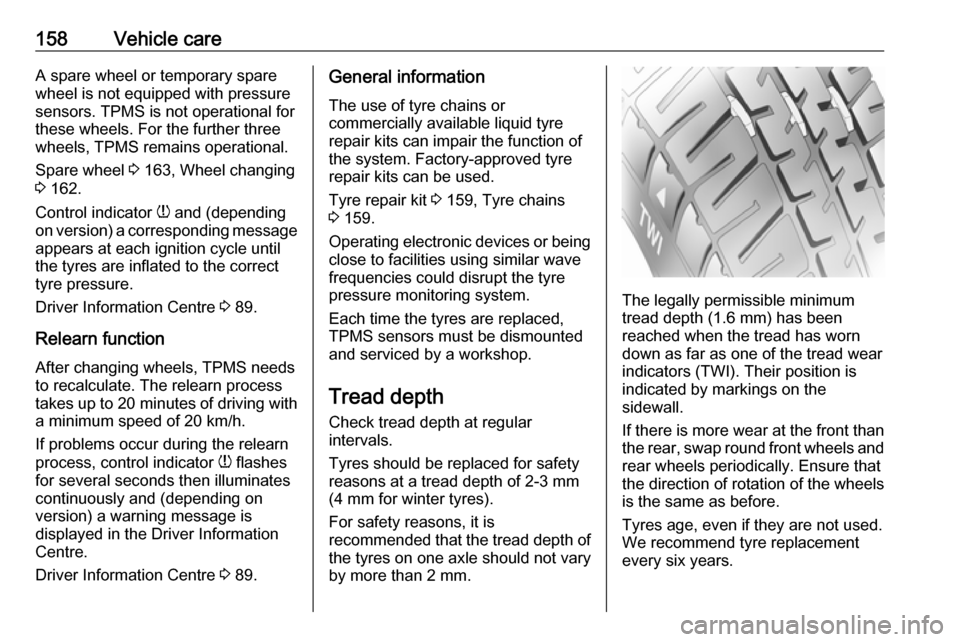display OPEL COMBO 2017 Manual user
[x] Cancel search | Manufacturer: OPEL, Model Year: 2017, Model line: COMBO, Model: OPEL COMBO 2017Pages: 195, PDF Size: 4.71 MB
Page 124 of 195

122Driving and operatingspeed is too high, the transmission
only switches to a higher gear via
kickdown 3 122.
When gearshifting is recommended
to improve fuel economy, control indicator [ or Ò illuminates in the
Driver Information Centre 3 84.
Electronic driving programmes
Eco mode E
When automatic mode is engaged,
the Eco mode can be selected to
reduce fuel consumption.
Eco mode selects the most suitable gear depending on the speed of the
vehicle, the engine speed and the
intensity with which the accelerator is pressed.
Activation
Press E on the selector lever housing.
Control indicator E is shown in the
transmission display to indicate
activation.
Deactivation
Eco mode is switched off by:
● pressing E again
● switching to manual mode
In order to protect the transmission at extremely high clutch temperatures,
an intermittent audible warning chime
may sound. In such cases, depress
the brake pedal, select N and apply
the parking brake to allow the clutch
to cool down.
Kickdown If the accelerator pedal is pressed
past the pressure point, the
transmission shifts to a lower geardepending on engine speed. Full
engine power is available for
acceleration.
If engine speed is too high the
transmission switches to a higher
gear, even in manual mode. Without
kickdown this automatic shift is not
effected in manual mode.
Fault
In the event of a fault, control indicator s is shown in the transmission
display.
Continued driving is possible,
provided the vehicle is driven with
care and anticipation. A warning
Page 125 of 195

Driving and operating123message may appear in the Driver
Information Centre in conjunction with
a warning chime 3 94.
Note
The volume of the warning chime
can also be adjusted via the Driver
Information Centre 3 89.
Have the cause of the fault remedied
by a workshop.Brakes
The brake system comprises two
independent brake circuits.
If a brake circuit fails, the vehicle can
still be braked using the other brake
circuit. However, braking effect is
achieved only when the brake pedal
is depressed firmly. Considerably
more force is needed for this. The
braking distance is extended. Seek the assistance of a workshop before
continuing your journey.
When the engine is not running, the
support of the brake servo unit
disappears once the brake pedal has been depressed once or twice.
Braking effect is not reduced, but
braking requires significantly greater
force. It is especially important to bear this in mind when being towed.
Control indicator R 3 83.
Antilock brake system
Antilock brake system (ABS)
prevents the wheels from locking.ABS starts to regulate brake pressure as soon as a wheel shows a tendency
to lock. The vehicle remains
steerable, even during hard braking.
ABS control is made apparent
through a pulse in the brake pedal
and the noise of the regulation
process.
For optimum braking, keep the brake
pedal fully depressed throughout the
braking process, despite the fact that
the pedal is pulsating. Do not reduce
the pressure on the pedal.
After starting off the system performs a self-test which may be audible.
Fault
In the event of a fault, control indicator
u illuminates in the instrument
cluster. Depending on version, a
corresponding warning message,
e.g. ABS unavailable , may also be
displayed in the Driver Information
Centre 3 89.
Page 127 of 195

Driving and operating125Hill start assistThe system helps prevent unintended
movement when driving away on
inclines.
When releasing the brake pedal after
stopping on an incline, the brakes
remain on for a further two seconds.
The brakes release automatically as
soon as the vehicle begins to
accelerate.
If control indicator Z 3 84 illuminates
while driving, there is a fault in the Hill
start assist. Depending on version, a
corresponding warning message,
e.g. Hill holder unavailable , may also
be displayed in the Driver Information
Centre 3 89. Seek the assistance of
a workshop to have the fault remedied.
The Hill start assist is not active
during an Autostop.
Stop-start system 3 114.Ride control systems
Traction Control system The Anti-Slip Regulator (ASR) is a
component of the Electronic Stability
Control (ESC).
ASR improves driving stability when
necessary, regardless of the type of
road surface or tyre grip, by
preventing the drive wheels from
spinning.
As soon as the drive wheels starts to
spin, engine output is reduced and
the wheel spinning the most is braked
individually. This considerably
improves the driving stability of the
vehicle on slippery road surfaces.
Page 128 of 195

126Driving and operating
ASR is operational after each engine
start as soon as the control indicator
R extinguishes.
When ASR operates, R flashes.
9 Warning
Do not let this special safety
feature tempt you into taking risks
when driving.
Adapt speed to the road
conditions.
Deactivation
ASR can be switched off when
spinning of drive wheels is required:
press ASR OFF briefly.
LED in button illuminates and,
depending on version, a
corresponding message, e.g. ASR
disconnect , may also be displayed in
the Driver Information Centre 3 89.
ASR is reactivated by pressing
ASR OFF again.
ASR is also reactivated the next time
the ignition is switched on.
Fault
ASR will switch off automatically in the event of a fault. Control indicator
R will illuminate in the instrument
cluster. Depending on version, a
corresponding message, e.g. ESP
unavailable , may also appear in the
Driver Information Centre 3 89.
Have the cause of the fault remedied by a workshop.
Control indicator R 3 84.
Electronic Stability Control
Electronic Stability Control (ESC)
improves driving stability when
necessary, regardless of the type of
road surface or tyre grip. It also
prevents the drive wheels from
spinning.
As soon as the vehicle starts to
swerve (understeer/oversteer),
engine output is reduced and the wheels are braked individually. This
considerably improves the driving
stability of the vehicle on slippery road
surfaces.
Page 130 of 195

128Driving and operating
Do not use the cruise control if it is notadvisable to maintain a constant
speed.
Switching on
Turn end of lever to the ON position;
control indicator m 3 89 illuminates in
the instrument cluster. Depending on
version, a corresponding message,
e.g. Cruise Control on , may also be
displayed in the Driver Information Centre 3 89.
Activation
Accelerate to the desired speed and
push lever upwards ( +); the current
speed is stored and maintained.
Accelerator pedal can be released.
Vehicle speed can be increased by depressing the accelerator pedal.
When the accelerator pedal is
released, the previously stored speed
is resumed.
Cruise control remains activated
while gearshifting.
Increase speed
With cruise control active, push lever
upwards ( +) or briefly push lever
upwards ( +) repeatedly: speed
increases continuously or in small
increments.Alternatively accelerate to the desired speed and store by pushing lever
upwards ( +).
Reduce speed With cruise control active, push lever
downwards ( -) or briefly push lever
downwards ( -) repeatedly; speed
decreases continuously or in small
increments.
Deactivation
Automatic deactivation: ● vehicle speed below approx. 30 km/h
● the brake pedal is depressed
● the clutch pedal is depressed
● the traction control system/Anti- Slip Regulator (ASR) or
Electronic Stability Control (ESC)
is operating
Resume stored speed
Press = at a speed above 30 km/h.
The stored speed will be obtained.
Page 131 of 195

Driving and operating129Switching off
Turn end of lever to the OFF position;
control indicator m extinguishes. The
stored speed is deleted. Switching off
the ignition also deletes the stored
speed.
Parking assist
The parking assist makes parking
easier by measuring the distance between the vehicle and obstacles,
and giving acoustic signals. It is the
driver, however, who bears full
responsibility for the parking
manoeuvre.
The system consists of four ultrasonic parking sensors in the rear bumper.
System operation
The parking assist is turned on
automatically when reverse gear is
engaged.
The intervals between the beeps
become shorter as the vehicle gets
closer to the obstacle. When the
distance is less than 30 cm, the
beeping is a continuous tone which
stops immediately when the distance
is increased.
FaultIn the event of a fault in the system,
r 3 84 illuminates in the instrument
cluster.
Depending on version, a
corresponding warning message,
e.g. Parking help unavailable , may
also be displayed in the Driver
Information Centre 3 89.
The following conditions could affect the system's performance:
● The ultrasonic sensors are not clean. Keep the bumper free ofmud, dirt, snow, ice and slush.
● The sensors are covered by frost
or ice.
● The rear doors / tailgate are open.
● An object was hanging out of the
rear doors / tailgate during the
last drive cycle. Once the object
has been removed, the parking
assist will return to normal
operation.
● An object or cover is attached to the rear of the vehicle.
Page 136 of 195

134Driving and operatingTerms for "natural gas " abroad:GermanErdgasEnglishCNG = Compressed
Natural GasFrenchGNV = Gaz Naturel (pour)
Véhicules - or -
CGN = carburantgaz
naturelItalianMetano (per auto)
Fuel filler cap
Only use genuine fuel filler caps.
Diesel-engined vehicles have special fuel filler caps.
Fuel cut-off system
In the event of a collision of a certain
severity, the fuel system is cut-off and
the engine is switched off
automatically, for safety reasons.
Resetting the fuel cut-off system;
refer to "Fuel system messages"
3 95.
Fuel consumption - CO
2-
Emissions
The fuel consumption (combined) of
the model Opel Combo is within a
range of 7.7 to 4.5 l/100 km.
Depending on country, the fuel
consumption is displayed in km/l. In
this case, the fuel consumption
(combined) of the model Opel Combo is within a range of 13.0 to 22.2 km/l.
The CO 2 emission (combined) is
within a range of 179 to 120 g/km.
For the values specific to your
vehicle, refer to the EEC Certificate of
Conformity provided with your vehicle or other national registration
documents.
General information
The official fuel consumption and
specific CO 2 emission figures quoted
relate to the EU base model with
standard equipment.
Fuel consumption data and CO 2
emission data are determined
according to regulation R (EC)
No. 715/2007 (in the latest applicableversion), taking into consideration the
vehicle weight in running order, as specified by the regulation.
The figures are provided only for the
purpose of comparison between different vehicle variants and mustnot be taken as a guarantee for the
actual fuel consumption of a
particular vehicle.
Additional equipment may result in
slightly higher results than the stated
fuel consumption and CO 2 figures.
Furthermore, fuel consumption is dependent on personal driving style as well as road and traffic conditions.
Natural gas
The fuel consumption information
was obtained using reference fuel
G20 (methane proportion
99 - 100 mol%) under prescribed
driving conditions. When using
natural gas with a lower proportion of
methane, the fuel consumption can
differ from the specified values.
Page 159 of 195

Vehicle care157Tyre pressure monitoringsystem
The Tyre Pressure Monitoring
System (TPMS) uses radio and
sensor technology to check tyre
pressure levels.Caution
Tyre pressure monitoring system
warns only about low tyre pressure condition and does not replace
regular tyre maintenance by the
driver.
The TPMS sensors monitor the air pressure in the tyres and transmit tyre
pressure readings to a receiver
located in the vehicle.
All wheels must be equipped with
pressure sensors and the tyres must
have the prescribed pressure.
Tyre pressure chart 3 185.
Note
In countries where the tyre pressure monitoring system is legally
required, the use of wheels without
pressure sensors will invalidate the
vehicle type approval.
Low tyre pressure condition
A detected low tyre pressure
condition is indicated by illumination
of control indicator w 3 86 together
with a warning chime. In vehicles with Multifunction version of the Driver
Information Centre, a corresponding message is also displayed.
If w illuminates, stop as soon as
possible and inflate the tyres as
recommended 3 185.
After inflating, driving may be
required to update the tyre pressure
values in the system. During this time
w may illuminate.
If w illuminates at lower temperatures
and extinguishes after some driving,
this could be an indicator for
approaching a low tyre pressure
condition. Check tyre pressure of all
four tyres.
If the tyre pressure must be reduced
or increased, switch off ignition.
Only mount wheels with pressure
sensors, otherwise the tyre pressure
value cannot be recognised by the
system and w flashes for several
seconds then illuminates
continuously. In vehicles with
Multifunction version of the Driver Information Centre, a corresponding
message is also displayed.
Page 160 of 195

158Vehicle careA spare wheel or temporary spare
wheel is not equipped with pressure
sensors. TPMS is not operational for
these wheels. For the further three
wheels, TPMS remains operational.
Spare wheel 3 163, Wheel changing
3 162.
Control indicator w and (depending
on version) a corresponding message appears at each ignition cycle untilthe tyres are inflated to the correct
tyre pressure.
Driver Information Centre 3 89.
Relearn function
After changing wheels, TPMS needs
to recalculate. The relearn process
takes up to 20 minutes of driving with
a minimum speed of 20 km/h.
If problems occur during the relearn
process, control indicator w flashes
for several seconds then illuminates
continuously and (depending on
version) a warning message is
displayed in the Driver Information
Centre.
Driver Information Centre 3 89.General information
The use of tyre chains or
commercially available liquid tyre
repair kits can impair the function of
the system. Factory-approved tyre
repair kits can be used.
Tyre repair kit 3 159, Tyre chains
3 159.
Operating electronic devices or being
close to facilities using similar wave
frequencies could disrupt the tyre
pressure monitoring system.
Each time the tyres are replaced, TPMS sensors must be dismounted
and serviced by a workshop.
Tread depth Check tread depth at regular
intervals.
Tyres should be replaced for safety
reasons at a tread depth of 2-3 mm
(4 mm for winter tyres).
For safety reasons, it is
recommended that the tread depth of
the tyres on one axle should not vary
by more than 2 mm.
The legally permissible minimum
tread depth (1.6 mm) has been
reached when the tread has worn
down as far as one of the tread wear
indicators (TWI). Their position is
indicated by markings on the
sidewall.
If there is more wear at the front than
the rear, swap round front wheels and
rear wheels periodically. Ensure that
the direction of rotation of the wheels
is the same as before.
Tyres age, even if they are not used.
We recommend tyre replacement
every six years.
Page 173 of 195

Vehicle care171Towing equipmentDo not clean the coupling ball bar with
a steam-jet or high-pressure jet
cleaner.
Interior care
Interior and upholstery Only clean the vehicle interior,
including the instrument panel fascia
and panelling, with a dry cloth or
interior cleaner.
Clean the leather upholstery with
clear water and a soft cloth. In case of
heavy soiling, use leather care.
The instrument cluster and the
displays should only be cleaned using
a soft damp cloth. If necessary, use a weak soap solution.
Clean fabric upholstery with a
vacuum cleaner and brush. Remove
stains with an upholstery cleaner.
Clothing fabrics may not be
colourfast. This could cause visible
discolourations, especially on light-coloured upholstery. Removable
stains and discolourations should be
cleaned as soon as possible.
Clean seat belts with lukewarm water or interior cleaner.Caution
Close Velcro fasteners as open
Velcro fasteners on clothing could
damage seat upholstery.
The same applies to clothing with
sharp-edged objects, like zips or
belts or studded jeans.
Plastic and rubber parts
Plastic and rubber parts can be
cleaned with the same cleaner as
used to clean the body. Use interior cleaner if necessary. Do not use any
other agent. Avoid solvents and petrol in particular. Do not use high-
pressure jet cleaners.